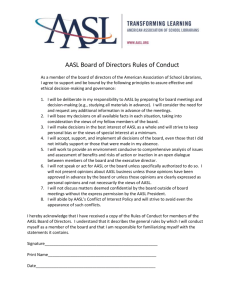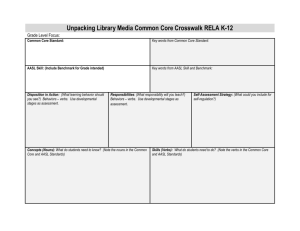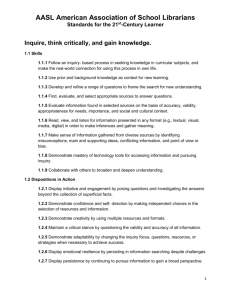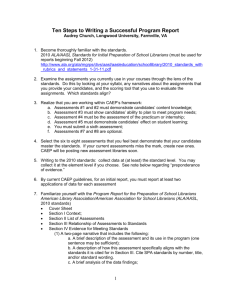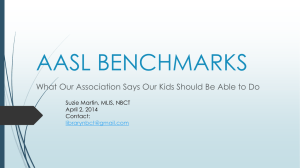ISTC 615 Model Syllabus - Towson University
advertisement
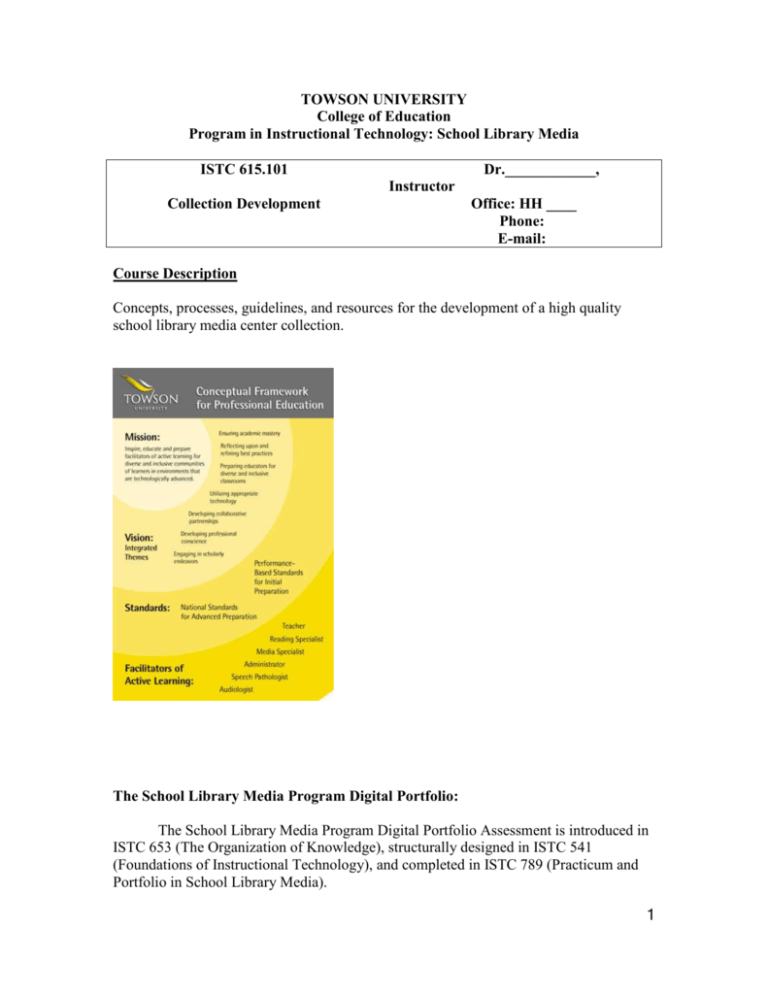
TOWSON UNIVERSITY College of Education Program in Instructional Technology: School Library Media ISTC 615.101 Dr.____________, Instructor Collection Development Office: HH ____ Phone: E-mail: Course Description Concepts, processes, guidelines, and resources for the development of a high quality school library media center collection. The School Library Media Program Digital Portfolio: The School Library Media Program Digital Portfolio Assessment is introduced in ISTC 653 (The Organization of Knowledge), structurally designed in ISTC 541 (Foundations of Instructional Technology), and completed in ISTC 789 (Practicum and Portfolio in School Library Media). 1 As candidates near completion of the program, they will write reflection statements correlating their program work, particularly as the work connects to PK-12 students. Candidates are encouraged to write reflections throughout their program of study aligning coursework to the AASL standards for the Initial Programs for School Library Media Specialist Preparation. It is not likely possible to complete the portfolio until a majority of coursework is completed. The portfolio is to be completed as part of (three credits) of the final six credit program course, ISTC 789 (Practicum and Portfolio in School Library Media). Candidates should archive digital and other copies of their work. AASL/ Standards (These are standards for the Initial Preparation of School Librarians) 1.1 Knowledge of learners and learning Candidates are knowledgeable of learning styles, stages of human growth and development, and cultural influences on learning. Candidates assess learner needs and design instruction that reflects educational best practice. Candidates support the learning of all students and other members of the learning community, including those with diverse learning styles, physical and intellectual abilities and needs. Candidates base twenty-first century skills instruction on student interests. 1.3 Instructional partner Candidates model, share, and promote effective principles of teaching and learning as collaborative partners with other educators. Candidates acknowledge the importance of participating in curriculum development, of engaging in school improvement processes, and of offering professional development to other educators as it relates to library and information use. 1.4 Integration of twenty-first century skills and learning standards Candidates advocate for twenty-first century literacy skills to support the learning needs of the school community. Candidates demonstrate how to collaborate with other teachers to plan and implement instruction of the AASL Standards for the21st-Century Learner and state student curriculum standards. Candidates employ strategies to integrate multiple literacies with content curriculum. Candidates integrate the use of emerging technologies as a means for effective and creative teaching and to support P-12 students' conceptual understanding, critical thinking and creative processes. 2.3 Respect for diversity Candidates demonstrate the ability to develop a collection of reading and information materials in print and digital formats that support the diverse developmental, cultural, social, and linguistic needs of P-12 students and their communities. 2.4 Literacy strategies Candidates collaborate with classroom teachers to reinforce a wide variety of reading instructional strategies to ensure P-12 students are able to create meaning from text. 3.2 Access to information Candidates support flexible, open access for library services. Candidates demonstrate their ability to develop solutions for addressing physical, social and intellectual barriers 2 to equitable access to resources and services. Candidates facilitate access to information in print, non-print, and digital formats. Candidates model and communicate the legal and ethical codes of the profession. 3.3 Information technology Candidates demonstrate their ability to design and adapt relevant learning experiences that engage students in authentic learning through the use of digital tools and resources. Candidates model and facilitate the effective use of current and emerging digital tools to locate, analyze, evaluate, and use information resources to support research, learning, creating, and communicating in a digital society. 5.1 Collections Candidates evaluate and select print, non-print, and digital resources using professional selection tools and evaluation criteria to develop and manage a quality collection designed to meet the diverse curricular, personal, and professional needs of students, teachers, and administrators. Candidates organize school library collections according to current library cataloging and classification principles and standards. 5.2 Professional Ethics Candidates practice the ethical principles of their profession, advocate for intellectual freedom and privacy, and promote and model digital citizenship and responsibility. Candidates educate the school community on the ethical use of information and ideas. 5.4 Strategic Planning and Assessment Candidates communicate and collaborate with students, teachers, administrators, and community members to develop a library program that aligns resources, services, and standards with the school's mission. Candidates make effective use of data and information to assess how the library program addresses the needs of their diverse communities. InTASC Standards Standard #1: Learner Development The teacher understands how learners grow and develop, recognizing that patterns of learning and development vary individually within and across the cognitive, linguistic, social, emotional, and physical areas, and designs and implements developmentally appropriate and challenging learning experiences. Standard #2: Learning Differences The teacher uses understanding of individual differences and diverse cultures and communities to ensure inclusive learning environments that enable each learner to meet high standards. Standard #3: Learning Environments The teacher works with others to create environments that support individual and collaborative learning, and that encourage positive social interaction, active engagement in learning, and self motivation. Standard #4: Content Knowledge The teacher understands the central concepts, tools of inquiry, and structures of the discipline(s) he or she teaches and creates learning experiences that make these aspects of the discipline accessible and meaningful for learners to assure mastery of the content. Standard #5: Application of Content 3 The teacher understands how to connect concepts and use differing perspectives to engage learners in critical thinking, creativity, and collaborative problem solving related to authentic local and global issues. Note: This course also incorporates the AASL Standards for the 21st Century Learner (these standards are designed for prek-12 students.) AASL. (2007). Standards for the 21st-Century Learner. Chicago: AASL The following concepts (some summarized) from the “Common Beliefs” of the AASL standards apply to and will be modeled in this ISTC 615 class: select, evaluate, and use information appropriately and effectively, provide children with an equitable access to books and reading, and to information technology in an environment that is safe and conducive to learning, become independent learners, gaining not only the skills, but also the dispositions to use those skills, along with an understanding of the students’ own responsibilities and self-assessment strategies, focus on multiple literacies, including digital, visual, textual, and technological, that have now joined information literacy as crucial skills for this century. seek diverse perspectives, gather and use information ethically, and use social tools responsibly and safely, share knowledge and learning with others, both in face-to-face situations and through technology, and collaborate with others to provide instruction, learning strategies, and practice in using the essential learning skills needed in the 21st century. Course Objectives Following completion of the course, the students will be able to: Evaluate, develop, and defend an objective set of written standards for the evaluation of print and non-print materials (AASL 5.1) Describe and evaluate an appropriate range of selection aids and review sources according to objective criteria (AASL 5.1), Develop strategies for the integration of school library media center (SLMC) resources and curricular resources within a local education agency (LEA) (AASL 1.3,1.4), Identify administrative and collaborative strategies for the implementation of print, non-print, electronic media and human resources to serve diverse populations and special needs clients (AASL 3.2,2.3) (InTASC 1, 2, 3, 4, 5) Identify, describe and utilize current technology in the acquisition of resource material (AASL 1.4), Explain functions and limitations of various media and review sources, describe critical issues that effect collection development and services including: 4 multicultural materials, gender stereotyping, special needs clients, censorship including Internet filtering and copyright laws (AASL 1.1, 5.2), Explain the relationship between copyright law, selection, evaluation, and access to information (AASL 3.2, 5.2), Critically analyze and evaluate library collections according to currently accepted local, regional and national standards (AASL 5.4), Use and evaluate computerized databases and acquisitions tools to develop collections (AASL 5.1), Evaluate instructional design elements in instructional software in terms of its fulfillment of a given set of educational criteria (AASL 2.4, 3.3), and Identify, access, and evaluate worldwide telecommunications networks and develop a virtual library appropriate for selective clients (AASL 4.1, 3.3). Course Content Selection Criteria Selection Policy Development & Evaluation Selection Tools for Books Selection Tools for Serials and Non-print Materials Government Documents Human Resources Acquisition and Collection Maintenance Collaborative Planning Copyright Censorship/Intellectual Freedom Texts Bishop, K. (2007). The collection programs in schools: concepts, practices and information sources. 4th. Ed. Englewood, CO: Libraries Unlimited. Recommended as background reading: AASL. (2007). Standards for the 21st-Century Learner. Chicago: AASL American Association of School Libraries & Association for Educational Communications and Technology. (1998). Information power: Building partnerships for learning. Chicago, IL: American Library Association. Additional Resources/Websites APA Tutorial: 5 Harvard University. (2012) APA exposed: Online tutorial. Retreived from; http://isites.harvard.edu/icb/icb.do?keyword=apa_exposed American Library Association: American Library Association. (2012) American Library Association. Retreived from: http://www.ala.org Includes ALA policies on intellectual freedom and the ALA office for intellectual freedom Multicultural Literature Database International Children Library. (2012). International Children’s Digital Library: A library for the world’s children. Retrieved from: http://en.childrenslibrary.org/ Universal Design for Learning Cast. (2012). Universal Design for Learning. http://www.cast.org/teachingeverystudent/ideas/tes/ Library Media State Curriculum Maryland State Department of Education. (2012). Library media curriculum. Retrieved from: http://marylandpublicschools.org/NR/rdonlyres/EC67FB12-FE6B-464AA2AD-D0C6307773E3/13092/SLMStandards.pdf Crosswalk of the Common Core Standards and the Standards for the 21st-Century Learner American Library Association. (2012). Crosswalk of the Common Core Standards and the Standards for the 21st-Century Learner. Retreived from: http://www.ala.org/aasl/guidelinesandstandards/commoncorecrosswalk E-book 6 Agosto, D.e. & Hughes-Hassell (Eds.). (2010). Urban teens in the library: research and practice—eEditions e-bookbundle. Chicago: American Library Association Editions. Monographs Alabaster, C. (2010). Developing an outstanding core collection: A guide for libraries. 2nd. Ed. Chicago: American Library Association Editions. Baumbach, D. J. & Miller, L.L. (2006). Less is more : A practical guide to weeding school library collections. Chicago: American Library Association. Rose, D. H. & Meyer, A. [Eds.]. (2006). A practical reader in universal design for learning. Cambridge, MA: Harvard Education Press. Russell, C. [Ed.] (2004). Complete copyright: An everyday guide for librarians. Chicago: American Library Association. Sullivan, M. (2010). Serving boys through readers’ advisory. Chicago: American Library Association Editions. Sample Course Requirements Participate in class discussions and activities Work cooperatively in teams Evaluate print, non-print and electronic resources appropriate for school library collections (individual) Read current journal articles and the text Share knowledge gleaned from the readings with the class (individual/oral & written) Online course activities Complete course assignments o Assignment #1: Review Sources o Assignment #2: Community Analysis Field Study o Assignment #3: Online ordering – in class activity o Assignment # 4: Reviewing Materials o Assignment # 5: Banned Books o Assignment # 6 Hot Issues: Research Project o Assignment # 7: Final Project/Assessment - Selection Policy Course Grading System (all assessments will be assigned point values) 7 95-100% = A 90-94 = A86-89 = B+ 80-85 = B 75-79 = C F= <75 Policy Statements Attendance Students are expected to attend every session. If you miss a session for an emergency or other circumstance beyond your control, it is your responsibility to contact the course instructor prior to class and to make up all work missed. Special Note: “Students should not attend classes or other university events from the onset of flu-like symptoms until at least 24 hours after the fever subsides without the use of fever reducing medications. Such absences will be considered excused absences; however, students are responsible for the material covered during the period of their absence.” Course assignments All assignments including the final course project must be completed for course credit. Assignments are due at various times throughout the course. Assignments that are late will be penalized for each day late. Incomplete grades It is university policy that an incomplete may not be given except in cases of emergency, illness or other circumstances beyond your control. If you have such an emergency, you should notify the course instructor at the earliest possible time. Academic Integrity Students are expected to maintain a high standard of academic integrity. Unauthorized assistance in preparing materials submitted as original work by you constitutes a violation of academic integrity. Inappropriate classroom conduct, cheating and plagiarism will result in academic disciplinary action by the course instructor or by the Graduate Studies Committee. See: Student Academic Integrity Policy, Towson University. References AASL. (2007). Standards for the 21st-Century Learner. Chicago: AASL Agosto, D.e. & Hughes-Hassell (Eds.). (2010). Urban teens in the library: research and 8 practice—eEditions e-bookbundle. Chicago: American Library Association Editions. Alabaster, C. (2010). Developing an outstanding core collection: A guide for libraries. 2nd. Ed. Chicago: American Library Association Editions. American Association of School Libraries & Association for Educational Communications and Technology. (1998). Information power: Building partnerships for learning. Chicago, IL: American Library Association. American Library Association. (2012) American Library Association. Retreived from: http://www.ala.org Includes ALA policies on intellectual freedom and the ALA office for intellectual freedom. American Library Association. (2012). Crosswalk of the Common Core Standards and the Standards for the 21st-Century Learner. Retreived from: http://www.ala.org/aasl/guidelinesandstandards/commoncorecrosswalk Baumbach, D. J. & Miller, L.L. (2006). Less is more : A practical guide to weeding school library collections. Chicago: American Library Association. Bishop, K. (2007). The collection programs in schools: concepts, practices and information sources. 4th. Ed. Englewood, CO: Libraries Unlimited. Cast. (2012). Universal Design for Learning. http://www.cast.org/teachingeverystudent/ideas/tes/ Harvard University. (2012) APA exposed: Online tutorial. Retreived from; http://isites.harvard.edu/icb/icb.do?keyword=apa_exposed 9 International Children Library. (2012). International Children’s Digital Library: A library for the world’s children. Retrieved from: http://en.childrenslibrary.org/ Maryland State Department of Education. (2012). Library media curriculum. Retrieved from: http://marylandpublicschools.org/NR/rdonlyres/EC67FB12-FE6B-464AA2AD-D0C6307773E3/13092/SLMStandards.pdf Rose, D. H. & Meyer, A. [Eds.]. (2006). A practical reader in universal design for learning. Cambridge, MA: Harvard Education Press. Russell, C. [Ed.] (2004). Complete copyright: An everyday guide for librarians. Chicago: American Library Association. Sullivan, M. (2010). Serving boys through readers’ advisory. Chicago: American Library Association Editions. 10
